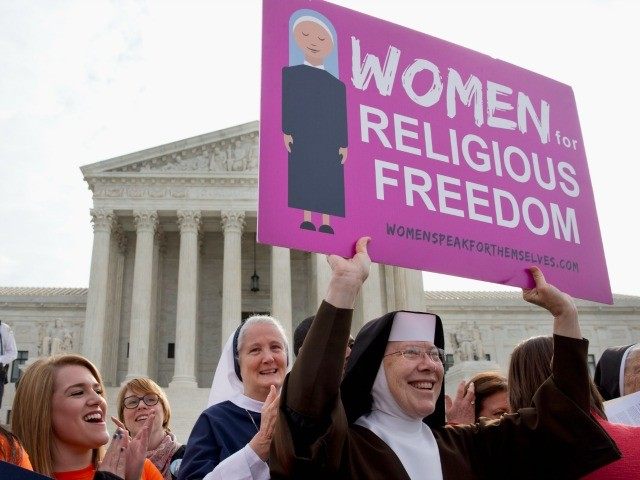Then-Speaker of the House Nancy Pelosi once infamously said of the Affordable Care Act, a.k.a. ObamaCare, “But we have to pass the bill so that you can find out what is in it away from the fog of the controversy.”
Well, the “fog of the controversy” lifted in 2010 when the President’s bill transforming our health care system was pushed through Congress and signed into law.
What we’ve had since is a storm of outrage.
It turns out that what was in the bill – taxpayer subsidized abortion, for instance – was, indeed, egregious. But we knew all along that ObamaCare contained support for abortion, the President’s denials notwithstanding.
It’s what was not in the bill – that the government would force religious non-profit groups to violate their faiths – that has resulted in over 50 lawsuits against the executive branch. Our case, Priests for Life vs. HHS, and six others consolidated with it under the title Zubik v. HHS, are now under review by the Supreme Court after oral arguments March 23.
The ministry in which we serve, Priests for Life, has brought forth one of those cases and was the first of the petitioners currently before the Court to challenge what has become known as the “HHS mandate.”
The mandate requires that religious non-profit entities like Priests for Life, Catholic charities, and Christian colleges be complicit in providing employees with abortifacients and other drugs and procedures that our faiths teach are gravely sinful. It demands that we obey the government instead of God. And it will levy crushing fines against us if we don’t.
The administration claims that the HHS mandate is based on an amendment to the Obamacare act passed by the House and Senate. The truth, however, is that the mandate, at least as drafted and imposed by the Departments of Health and Human Services, Treasury, and Labor, was not authorized by Congress. To say that the regulation has a legislative basis is akin to one of those Hollywood movies that claims to be “based on a true story” – the connection is tenuous, at best.
The HHS mandate is, basically, a device invented by the administration. As convincingly argued by the Cato Institute and the Independent Women’s Forum in a friend-of-the-court brief filed in support of the 37 religious petitioners in Zubik vs. Burwell, federal agencies “have overstepped their bounds” in creating a “bizarre and unprecedented” rule that tramples on religious liberty.
The amendment to the Obamacare bill that is used to justify the creation of the HHS mandate required that employers’ insurance plans provide coverage for women’s “preventive care and screenings.” But it did not specify abortion-inducing drugs and contraceptives. Congress was talking about prevention of disease, not of pregnancy.
Once Obamacare became law, the Department of Health and Human Services contracted with the Institute of Medicine, a non-governmental advisory agency, to make recommendations for what should be included in “preventive care.” Six months later, after inviting groups like Planned Parenthood to testify before it, the IOM issued a report that urged coverage for 20 different kinds of FDA-approved birth control, four of which can cause abortions.
Now, employers would be required to provide coverage for abortifacients and other drugs and procedures that are highly objectionable to many people of faith. But again, this pressure did not come from Congress. In fact, Congress knows that if it wants, it can include in legislation an exemption from the strict protections that the Religious Freedom Restoration Act (RFRA) gives to Americans and groups like Priests for Life. But Congress made no such exception in the Affordable Care Act, and therefore RFRA applies to it.
HHS quickly adopted the IOM report and issued the first version of the HHS mandate. Years and several versions of the regulation later, the government is still arguing that it has the authority to decide which religious groups it will exempt from the mandate – that is, favor – and which it will not – that is, disfavor.
Under the mandate’s current language, churches do not have to violate their beliefs, but entities like the Priests for Life and the Westminster Theological Seminary do. Why? Because federal civil servants say they can discern who is sufficiently religious and who is not.
As the Cato Institute and the Independent Women’s Forum point out, the federal departments that came up with these distinctions have no ability or expertise to make them; they certainly don’t have the authority – not in America.
The Cato/IWF brief argues that the Supreme Court shouldn’t even bother weighing whether the HHS mandate violates the Religious Freedom Restoration Act. They say that the Court should strike down the regulation because “Congress in no way, shape, or form delegated to HHS the authority to regulate religion—much less to make untenable distinctions among religious groups.”
Ultimately, then, Priests for Life v. HHS involves the separation of powers – the executive branch should not appropriate the powers of the legislative branch. But the case also involves the separation of church and state – the government should not be picking and choosing religious groups for reward and punishment.
Father Frank Pavone is National Director, Priests for Life

COMMENTS
Please let us know if you're having issues with commenting.